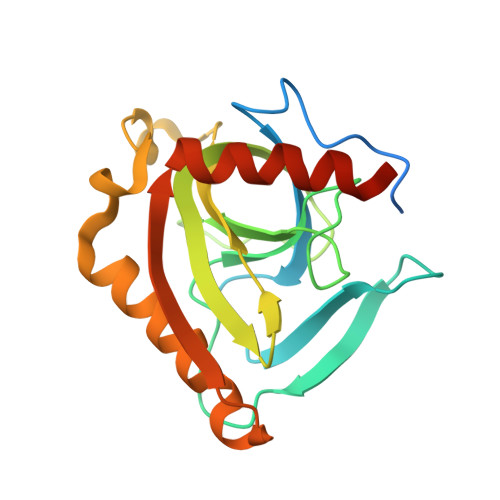Crystal structure of the hyperthermophilic inorganic pyrophosphatase from the archaeon Pyrococcus horikoshii.
Liu, B., Bartlam, M., Gao, R., Zhou, W., Pang, H., Liu, Y., Feng, Y., Rao, Z.(2004) Biophys J 86: 420-427
- PubMed: 14695284
- DOI: https://doi.org/10.1016/S0006-3495(04)74118-1
- Primary Citation of Related Structures:
1UDE - PubMed Abstract:
A homolog to the eubacteria inorganic pyrophosphatase (PPase, EC 3.6.1.1) was found in the genome of the hyperthermophilic archaeon Pyrococcus horikoshii. This inorganic pyrophosphatase (Pho-PPase) grows optimally at 88 degrees C. To understand the structural basis for the thermostability of Pho-PPase, we have determined the crystal structure to 2.66 A resolution. The crystallographic asymmetric unit contains three monomers related by approximate threefold symmetry, and a hexamer is built up by twofold crystallographic symmetry. The main-chain fold of Pho-PPase is almost identical to that of the known crystal structure of the model from Sulfolobus acidocaldarius. A detailed comparison of the crystal structure of Pho-PPase with related structures from S. acidocaldarius, Thermus thermophilus, and Escherichia coli shows significant differences that may account for the difference in their thermostabilities. A reduction in thermolabile residues, additional aromatic residues, and more intimate association between subunits all contribute to the larger thermophilicity of Pho-PPase. In particular, deletions in two loops surrounding the active site help to stabilize its conformation, while ion-pair networks unique to Pho-PPase are located in the active site and near the C-terminus. The identification of structural features that make PPases more adaptable to extreme temperature should prove helpful for future biotechnology applications.
Organizational Affiliation:
Laboratory of Structural Biology, Tsinghua University and National Laboratory of Biomacromolecules, Institute of Biophysics, Chinese Academy of Sciences, Beijing, China.














